#ambystomatidae
Text



Barred Tiger Salamander (Ambystoma mavortium mavortium), larva/tadpole, family Ambystomatidae, West TX, USA
This is a subspecies of the Western Tiger Salamander.
photograph by John P Clare
#salamander#ambystoma#tiger salamander#ambystomatidae#amphibian#herpetology#animals#nature#north america
2K notes
·
View notes
Text
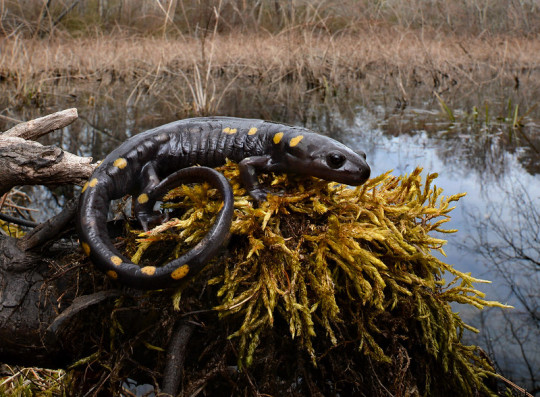
A spotted salamander (Ambystoma maculatum) perches on moss in Suffolk County, New York, USA
Alex Roukis
#spotted salamander#salamanders#amphibians#ambystoma maculatum#ambystoma#ambystomatidae#urodela#amphibia#chordata#wildlife: new york#wildlife: usa
2K notes
·
View notes
Text

It's salamander season again.
#spotted salamander#salamander#salamander eggs#eggs#egg mass#pond#poo#vernal#vernal pond#vernal pool#Ambystoma maculatum#nature#naturalist#sketch#watercolor#pencil#sketchbook#wildlife#animal#amphibian#Ambystomatidae#science#biology#pond life
371 notes
·
View notes
Photo
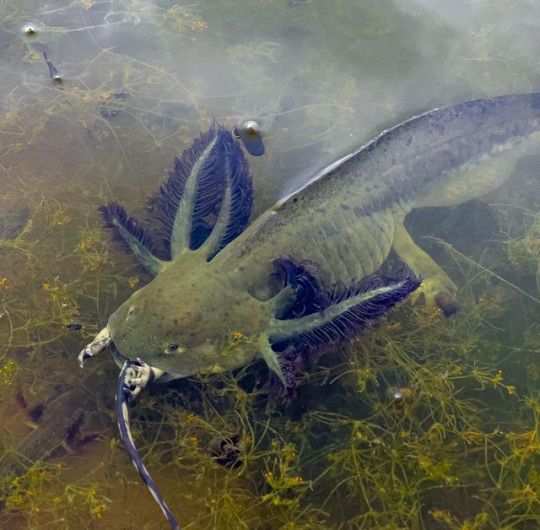
Barred Tiger Salamander
#western tiger salamander#barred tiger salamander#salamander#Ambystoma mavortium#mole salamander#Amphibia#Urodela#Ambystomatidae#Ambystoma#upl
2K notes
·
View notes
Photo

Spotted salamander (Ambystoma maculatum) in Georgia, U.S.
Noah K. Fields
2K notes
·
View notes
Photo
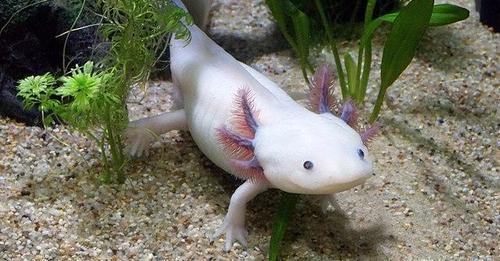
Axolotls Can Regenerate Their Brains
These adorable salamanders are helping unlock the mysteries of brain evolution and regeneration.
The axolotl (Ambystoma mexicanum) is an aquatic salamander renowned for its ability to regenerate its spinal cord, heart and limbs. These amphibians also readily make new neurons throughout their lives. In 1964, researchers observed that adult axolotls could regenerate parts of their brains, even if a large section was completely removed. But one study found that axolotl brain regeneration has a limited ability to rebuild original tissue structure.
So how perfectly can axolotl’s regenerate their brains after injury?
As a researcher studying regeneration at the cellular level, I and my colleagues in the Treutlein Lab at ETH Zurich and the Tanaka Lab at the Institute of Molecular Pathology in Vienna wondered whether axolotls are able to regenerate all the different cell types in their brain, including the connections linking one brain region to another. In our recently published study, we created an atlas of the cells that make up a part of the axolotl brain, shedding light on both the way it regenerates and brain evolution across species...
Read more: https://www.freethink.com/science/axolotls-brains
98 notes
·
View notes
Photo



Axolotl
The axolotl genome is the second longest in the animal kingdom, with 32 billion base pairs. That’s 10 times as long as the human genome.
The impossibly silly branches that grow from the axolotl’s head might not seem practical, but they’re actually the salamander’s gills. The filaments attached to the long gills increase surface area for gas exchange.
It’s not unusual for amphibians to be able to regenerate, but axolotls take it to the next level. On top of being able to regenerate limbs, the animal can also rebuild their jaws, spines, and even brains without any scarring.
The rarest axolotl color that is practically obtainable in real life is the firefly color. It is dark, like the wild type axolotl, but with a fluorescent green tail that glows in the dark. Other very rare but almost impossible to obtain axolotl colors include enigma, chimera and mosaic.
They’re critically endangered. A 2019 assessment by the International Union for the Conservation of Species found only between 50 and a thousand axolotls are left in the wild - and their populations are dropping.
4 notes
·
View notes
Photo

Animals of the Photo Ark - Blue-Spotted Salamander (Ambystoma laterale)
Family: Mole Salamander Family (Ambystomatidae)
IUCN Conservation Status: Least Concern
Named for the pale blue spots that stand out on its glossy black body and warn predators of its mild toxicity, the Blue-Spotted Salamander can be found in damp deciduous forests and swampy habitats in southeastern Canada and the northeastern USA. It typically lives away from water, but like most amphibians it must keep its skin damp in order to breath and as such it typically spends the day buried among leaf litter or hidden under rocks to prevent the sun from drying it out. At night it emerges to feed on small invertebrates, and while its exact diet is poorly known it likely consists of earthworms, slugs, snails and isopods. During the spring, large numbers of Blue-Spotted Salamanders travel to temporary pools created by seasonal rain in order to reproduce - after a brief courtship that involves the male nuzzling a female with his snout and using his jaws to cling to her back, he deposits a spermatophore (a “package” of sperm cells) which she takes into her body through her cloaca to fertilize her up to 500 eggs, which she will later attach to submerged rocks or vegetation. Around 1 month later the eggs hatch into fully-aquatic, limbless larvae with external gills - these young salamanders feed on aquatic invertebrates and gradually develop their legs before loosing their gills and transitioning to life on land in the summer of the year they were born. Blue-Spotted Salamanders are capable of hybridizing with the closely-related Jefferson’s Salamander (Ambystoma jeffersonianum) to create a unique “hybrid species”, the Tremblay’s Salamander, which are always born as females and must mate with a male Blue-Spotted Salamander or Jefferson’s Salamander in order to reproduce.
------------------------------------------------------------------------------
The photo above is from the National Geographic Photo Ark, and was taken by Joel Sartore. To see more of Sartore’s amazing work and support the Photo Ark, follow the link below:
https://www.nationalgeographic.org/projects/photo-ark/?locale=en
#blue-spotted salamander#salamander#salamanders#amphibians#amphibian#herpetofauna#zoology#biology#Herpetology#animal#animals#wildlife#joel sartore#photo ark
5 notes
·
View notes
Text


🦎 YELLOW-SPOTTED SALAMANDER 🦎
Scientific Name: Ambystoma maculatum
Family: Ambystomatidae
Class: Amphibian
Length: 6-8 in. (2.4-3.1 cm)
Weight: 0.45 oz (12.8 g)
Lifespan: 20-30 years
Location: Eastern United States and Canada
Diet: Worms, slugs, snails, spiders, millipedes, crickets, beetles, ants, and other invertebrates



Behavior: Nocturnal, communicate using touch and chemicals
Offspring: Up to 200 eggs per clutch
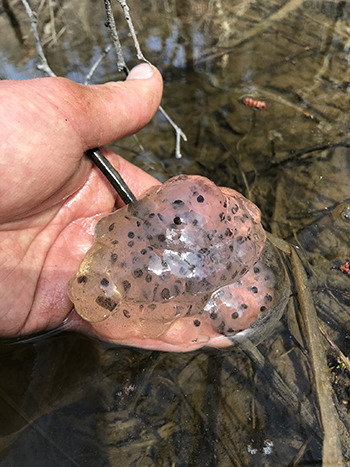

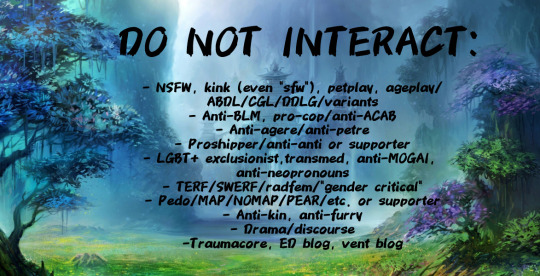
ANIMAL REQUESTS OPEN!
PLEASE RESPECT THE BANNERS!
#agere animal cards#aminals#card: yellow-spotted salamander#card: spotted salamander#class: amphibians#trypophobia tw#bugs tw#eggs tw
3 notes
·
View notes
Text
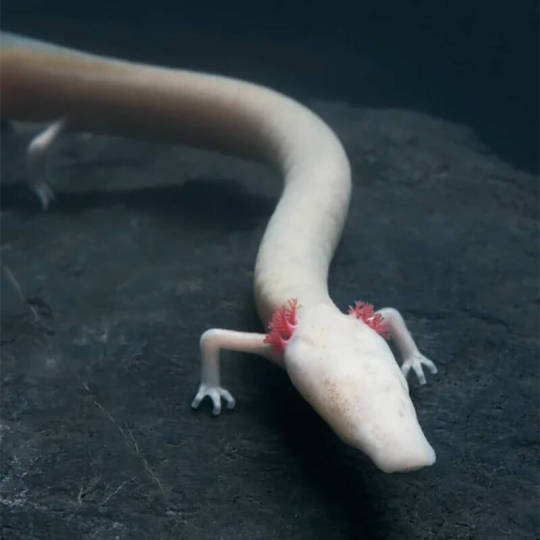
the olm needs more love so , here are some facts about the olm.
1.Olms might be the longest-lived amphibian species. Olms can live for at least 50 years, and one study suggests a maximum lifespan of over 100 years
2.Olms are blind. The eyes of the olm are underdeveloped, covered by a layer of skin. It's an adaptation to its dark surroundings. Though the eyes are regressed, they retain a sensitivity to light. Olm larvae have normal eyes for the first four months of life before they start to regress. By the time they are adults, olms are blind.
3.They have translucent skin. Since they spend their entire lives in complete darkness, olms have skin devoid of pigment, giving them a whitish-pink color. Their internal organs can be seen through the skin on their abdomens.
4.They only live in underground caves. Olms are entirely aquatic and found only in the deep underground lakes and pools of caves in the Dinaric Alps — parts of Slovenia, Italy, Croatia, and Herzegovina.
5.They can go a long time between meals. Olms have small mouths with tiny teeth that form a sieve to keep larger food particles in their mouths. They feed on insect larvae, small crabs, and snails, which they swallow whole. Olms can consume large amounts of food at once and store nutrients in the liver. When food is scarce, they reduce their metabolic activity and even reabsorb their own tissues. Experiments show they can live up to 10 years without food.
6.Olms were once thought to be baby dragons. Their natural habitat is mostly inaccessible to people, but after heavy rains, olms occasionally wash up from their underground lairs. Medieval legend considered them baby dragons — their snake-like bodies and frilly gills corresponded to descriptions of dragons, and their soft pale skin looked like that of a human newborn.
9.Olms never grow up. Unlike most amphibians, olm larvae do not go through a distinct period of metamorphosis. Instead, the larvae develop directly into adults at about four months of age, but they retain some of their juvenile characteristics, like frilly gills and tail fins.
10.In summary, while axolotls and olms both belong to the family Ambystomatidae and share some similarities, they have distinct evolutionary journeys. Axolotls originated in ancient Mexican lakes and have a more recent evolutionary history, while olms have adapted to life in dark caves over millions of years. Understanding the origin and evolution of these fascinating creatures provides valuable insights into the diversity and adaptability of amphibians.
1 note
·
View note
Photo

Spotted salamander (Ambystoma maculatum)
Photo by Alan Cressler
#egg#spotted salamander#ambystoma maculatum#ambystoma#ambystomatidae#salamandroidea#urodela#caudata#batrachia#amphibia#tetrapoda#vertebrata#chordata
444 notes
·
View notes
Text

Streamside Salamander (Ambystoma barbouri), family Ambystomatidae, northern KY, USA
photograph by John P. Clare
2K notes
·
View notes
Text
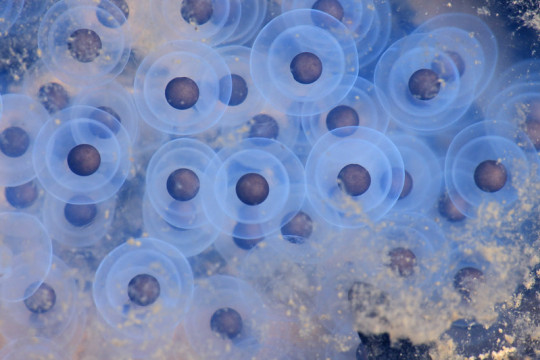
The eggs of a spotted salamander (Ambystoma maculatum) in a pool on Pigeon Mountain, Georgia, USA
by Alan Cressler
#spotted salamander#salamanders#amphibians#ambystoma maculatum#ambystoma#Ambystomatidae#urodela#amphibia#chordata#wildlife: georgia#wildlife: usa#wildlife: north america
199 notes
·
View notes
Text

#Ambystoma opacum#marbled salamander#mole salamander#salamander#animal#wildlife#nature#creative commons#ambystomatidae#urodela#amphibia#chordata
9 notes
·
View notes
Photo

Carnivorous plants have a taste for salamanders, scientists find | The Guardian
Biologists have discovered evidence that carnivorous plants in Canada feast on young salamanders, in what is believed to be the first instance of vertebrate consumption by plants in North America.
In study published in the journal Ecology, a pair of biologists in the province of Ontario found that northern pitcher plants – also known as turtle socks – devour juvenile spotted salamanders.
M Alex Smith, a professor of biology at Guelph University first discovered a salamander in a pitcher plant accidentally: he was leading a group of university students on a field course in Ontario’s Algonquin Park. But the sighting of the small reptile in the plant felt like a “WTF moment”, Smith told the Guardian in an email.
After consulting with the park’s resident salamander expert, Patrick Moldowan, a PhD student at the University of Toronto, the two suspected Smith’s discovery might have been more than a chance sighting. After surveying pitcher plants in Algonquin, Moldowa found that 20% of plants had at least one juvenile spotted salamander in them. “The second WTF moment,” said Smith.
The pitcher plant is one of nearly 600 carnivorous plants found throughout the world. Inhabiting much of Canada and the eastern United States, the pitcher thrives in low-nutrient areas, such as bogs.
The plant is well known for its appetite of invertebrates, like spiders and other small insects – but the discovery of decomposing salamanders significantly expands the scope of what plants may be consuming – and raises numerous questions.
“Are plants a significant form of mortality for the salamanders? Are the salamanders a significant form of nutrition for the plants? Are the salamanders, in fact, not a good thing for the plants?” said Smith.
What makes the research especially tantalizing, said Smith, is that while the plants and salamanders are relatively common sightings in the park, researchers didn’t realize the deadly relationship between the two.
#Purple Pitcher Plant#Northern Pitcher Plant#Sarracenia purpurea#Sarracenia#Sarraceniaceae#Ericales#pitcher plant#plants#carnivorous plants#predation#Spotted Salamander#Ambystoma maculatum#Ambystoma#Ambystomatidae#Salamandroidea#Urodela#Caudata#Lissamphibia#Amphibia#salamander#amphibian#Algonquin Provincial Park#Ontario#Canada
24 notes
·
View notes
Photo

Spotted salamander (Ambystoma maculatum) egg mass in the U.S.
Noah K. Fields
206 notes
·
View notes